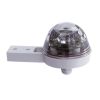Hydreon RG-15 Optical Rain Gauge
Features
- Features nominal accuracy of within 10% compared with tipping bucket
- Low power consumption makes it well-suited for solar charged applications
- RS-232 serial communications for configuration and data collection
- Expedited repair and warranty service
- Lifetime technical support
- More
Overview
The Hydreon RG-15 Solid State Tipping Bucket is a rainfall-measuring device intended to replace conventional tipping buckets. The RG-15 is rugged, reliable, maintenance-free and features a nominal accuracy of within 10%. The RG-15 is designed to replace tipping bucket rain gauges in many applications where their maintenance requirements make them impractical.
Design
The RG-15 uses beams of infrared light within a plastic lens about the size of a tennis ball. The round surface of the lens discourages the collection of debris, and the RG-15 has no moving parts to stick to, and no water-pathways to clog. The device features an open-collector output that emulates a conventional tipping bucket, as well as serial communications that provide more detailed data and allow for configuration of the device.
Mechanics
The RG-15 may be configured through the serial port, or optionally via DIP switches. Power consumption of the RG-15 is very low, and the device is well-suited to solar-power applications. Dip Switches can control the units (inches or millimeters) and resolution (0.01″/0.2mm or 0.001″/0.02mm) of the device. Commands can also be sent via the RS232 serial port to override them.
| Nominal Accuracy | ±10%1 |
| Input Voltage | Range 5-15 VDC 50V surge on J1 Reverse polarity protected to 50V Alternative 3.3VDC through pin 8 on J2 |
| Current Drain | 110 μA nominal. (No outputs on, dry not raining) 2-4 mA when raining |
| Output | NPN Open Collector Output 500 mA / 80V / 300mW Max |
| Operating Temperature | -40°C to +60°C (Will not detect rain when freezing) |
| Output Resolution | 0.01in / 0.2mm Alternative 0.001in / 0.02mm |
| RS232 Port | 3.3V |
| Supported Baud Rates | 1200, 2400, 4800, 9600, 19200, 38400, 57600 |
1Field accuracy will vary
In The News
Spring 2025 Environmental Monitor Available Now
In the Spring 2025 edition of the Environmental Monitor, we highlight partnerships across the world and the importance of collaboration between government agencies, universities, environmental groups, local communities, and other stakeholders. From great white shark research in Cape Cod to monitoring fisheries in Lake Erie, this latest edition underscores partnerships that connect stakeholders in a watershed through environmental data. With an emphasis on data sharing, a combination of real-time and discrete sampling keeps the public and partners informed of environmental conditions. Our writers also sought out science professionals dedicated to working with peers within and outside of the environmental sector.
Read MoreMonitoring Mariculture in the Gulf of Alaska
The mariculture industry in the Gulf of Alaska has been steadily growing in recent years, guided by ongoing research to help refine farm location and cultivation practices. A subset of aquaculture, mariculture focuses on rearing organisms in the open ocean. In Alaska, finfish farming is illegal, so most farms cultivate kelp, oysters, or a combination of the two. These small, locally operated farms started popping up in the Gulf of Alaska in the early 1990s, when shellfish farming first became legal. Kelp farming did not begin to catch on in the state until 2016. Many of the coastal areas that have grown interested in mariculture are historically commercial fishing communities.
Read MoreSupplying Seattle’s Drinking Water: Using Data Buoys to Monitor the Cedar River Municipal Watershed
Providing clean, safe, and reliable drinking water for the 1.6 million people in the greater Seattle area is a top priority for Seattle Public Utilities (SPU). With limited water supplies, SPU dedicates considerable resources to maintain its watersheds and mountain reservoirs. About 70 percent of Seattle Water comes from the Cedar River Municipal Watershed , and the other 30 percent comes from the South Fork Tolt River Watershed . [caption id="attachment_39574" align="alignnone" width="940"] Data buoy in Chester Morse Lake . (Credit: Kevin Johnson / Seattle Public Utilities) [/caption] Jamie Thompson, a fisheries biologist at SPU, monitors aquatic ecosystems centered on fish listed under the U.S. Endangered Species Act (ESA).
Read More







